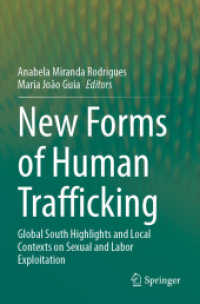- ホーム
- > 洋書
- > 英文書
- > Psychology
Full Description
In Dostoyevsky's Stalker, we discover how the arts may illuminate psychiatry and psychoanalysis, as well as how these disciplines may elucidate works of literature, art, and cinema. Examining a diversity of authors, artists, historical figures, and psychopaths over the course of modern history, this groundbreaking collection of essays proposes a paradigm shift in psychiatry, based on the idea that some symptoms of mental illness may have constructive uses and may be used by the sufferer for mental and spiritual growth instead of going untreated or else being "analyzed away."
Contents
Chapter 1 Preface
Chapter 2 Acknowledgments
Chapter 3 Introduction
Part 4 PART I: VARIATIONS ON A THEME OF SHAME
Chapter 5 1. Shame, the "As-if" Personality, and the Search for Identity
Chapter 6 2. Anton Chekov's "The Darling": Imitative Pseudo-Relationships
Chapter 7 3. Woody Allen's Zelig: The Human Chameleon
Chapter 8 4. Patricia Highsmith's The Talented Mr. Ripley: Better a Fake Somebody than a Real Nobody
Chapter 9 5. Reinvented Selves: Frank Abagnale's Catch Me If You Can and James Thurber's "The Secret Life of Walter Mitty
Chapter 10 6. Henry David Thoreau's Alter Egos: Ralph Waldo Emerson and JOhn Thoreau Jr.
Chapter 11 7. Fyodor Dostoyevsky's Underground Man and the Psychogenesis of Stalking
Chapter 12 8. The Case of the Quadriplegic Cyberterrorist
Chapter 13 9. The Unabomber at Harvard: A Murderous Phoenix
Chapter 14 10. The Unabomber, the Underground Man, and Asperger Syndrome
Chapter 15 11. Anton Chekhov's "The Man in a Case": Laughter that Killed
Chapter 16 12. Glenn Gould: the "Cased-in Man" Syndrome
Chapter 17 13. Homophobic Dysphoria in Annie Proulx's Brokeback Mountain
Chapter 18 14. A Shame-Inducing Epiphany in James Joyce's "The Dead"
Chapter 19 15. Anton Chekhov's "Lady with the Pet Dog": A Womanizer Learns to Love
Chapter 20 16. Joseph Conrad's Lord Jim: Inner and Outer Courts of Inquiry
Chapter 21 17. Edward Hopper's Last Painting, Two Comedians: An Ego-Absolving Gloss
Chapter 22 18. Alexander Pushkin's "The Shot": Revenge, a Dish Best Savored Cold
Part 23 PART II: POST-TRAUMATIC STRESS DISORDER
Chapter 24 19. Introduction: The Many Facets of PTSD
Chapter 25 20. Nathaniel Hawthorne's "Wakefield": Sleepwalker in a Mental Jail
Chapter 26 21. Frederick Law Olmsted's Childhood Traumas and the Birth of Psychoarchitecture
Chapter 27 22. Leo Tolstoy's "God Sees the Truth, but Waits": Through Suffering Comes Redemption
Chapter 28 23. Alger Hiss and Whittaker Chambers: A Real-life Ivan and Makar
Chapter 29 24. Henry David Thoreau's "Wilderness Therapy": Sensory Awareness in Nature
Chapter 30 25. The Great Deeds of Henry David Thoreau, Mohandas Gandhi, and Martin Luther King, Jr.: Crisis, Preparation, and a Deliberative Moment
Chapter 31 26. Introduction: The Creative Use of Alternate States of Consciousness
Chapter 32 27. Joseph Conrad's The Secret Sharer and Autoscopic Illusion
Chapter 33 28. Friedrich August Kekulé's Apparition of a Snake and the Structure of the Benzene Ring
Chapter 34 29. Henry David Thoreau: An Imaginary Mountain, A Symbolic Tombstone
Chapter 35 30. Demonic Hallucinations and Patricidal Guilt: Dostoyevsky's Ivan Karamazov and Freud's Bavarian Artist
Chapter 36 31. The Three Phantoms of Herman Melville's Moby Dick
Part 37 PART IV: MOOD IMAGERY IN LITERATURE
Chapter 38 32. Introduction: Icarus, Daedalus, and Bipolar Disorder
Chapter 39 33. Manic-Depressive Mood Swings in Albert Camus' The Fall
Chapter 40 34. Bipolar Imagery in Henry David Thoreau's Journals
Chapter 41 Bibliography








